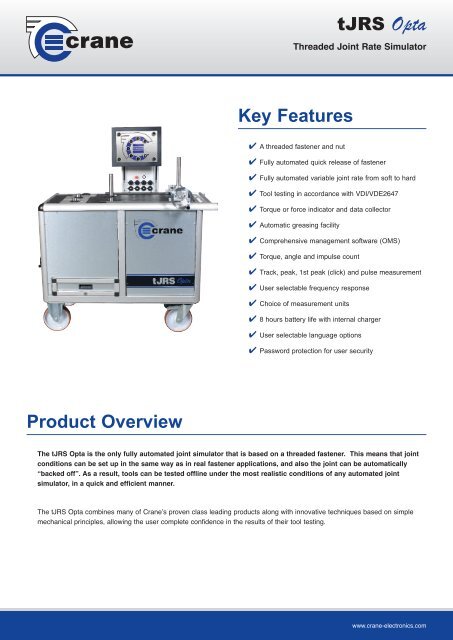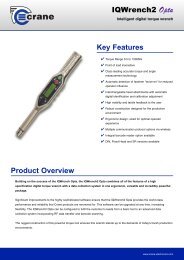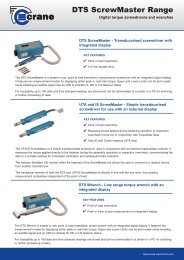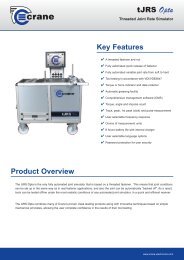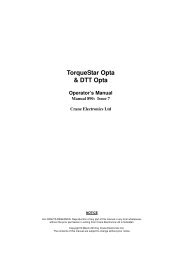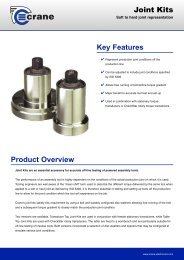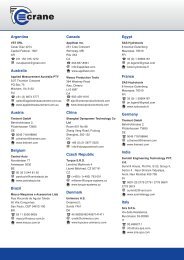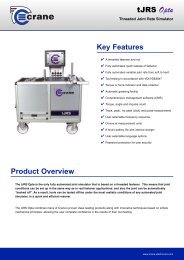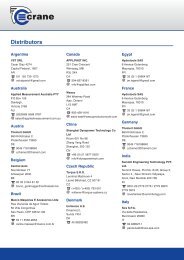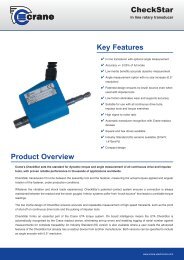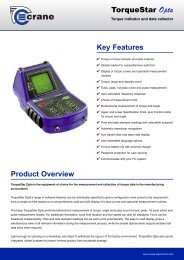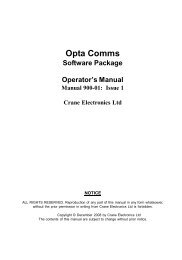tJRS Opta Key Features Product Overview - Crane Electronics Ltd
tJRS Opta Key Features Product Overview - Crane Electronics Ltd
tJRS Opta Key Features Product Overview - Crane Electronics Ltd
Create successful ePaper yourself
Turn your PDF publications into a flip-book with our unique Google optimized e-Paper software.
<strong>tJRS</strong> <strong>Opta</strong><br />
Threaded Joint Rate Simulator<br />
<strong>Key</strong> <strong>Features</strong><br />
4 A threaded fastener and nut<br />
4 Fully automated quick release of fastener<br />
4 Fully automated variable joint rate from soft to hard<br />
4 Tool testing in accordance with VDI/VDE2647<br />
4 Torque or force indicator and data collector<br />
4 Automatic greasing facility<br />
4 Comprehensive management software (OMS)<br />
4 Torque, angle and impulse count<br />
4 Track, peak, 1st peak (click) and pulse measurement<br />
4 User selectable frequency response<br />
4 Choice of measurement units<br />
4 8 hours battery life with internal charger<br />
4 User selectable language options<br />
4 Password protection for user security<br />
<strong>Product</strong> <strong>Overview</strong><br />
The <strong>tJRS</strong> <strong>Opta</strong> is the only fully automated joint simulator that is based on a threaded fastener. This means that joint<br />
conditions can be set up in the same way as in real fastener applications, and also the joint can be automatically<br />
“backed off”. As a result, tools can be tested offline under the most realistic conditions of any automated joint<br />
simulator, in a quick and efficient manner.<br />
The <strong>tJRS</strong> <strong>Opta</strong> combines many of <strong>Crane</strong>’s proven class leading products along with innovative techniques based on simple<br />
mechanical principles, allowing the user complete confidence in the results of their tool testing.<br />
www.crane-electronics.com
<strong>tJRS</strong> <strong>Opta</strong><br />
Threaded Joint Rate Simulator<br />
<strong>Product</strong> Description<br />
The <strong>tJRS</strong> <strong>Opta</strong> from <strong>Crane</strong> <strong>Electronics</strong> is the latest generation Joint Rate Simulator featuring a system covered by serveal<br />
patents. As with all products in the <strong>Opta</strong> range the <strong>tJRS</strong> integrates seamlessly into the OMS software package to provide a<br />
complete torque measurement solution.<br />
Traditionally, automated joint simulators have used friction brake systems in place of a threaded fastener. The reasons for this<br />
were to overcome the two main issues which are having to reverse, or back-off, after each rundown and the cumbersome<br />
nature of re-configuring the joint characteristic.<br />
Whilst friction brakes can easily be reset, removing the back-off issue, they introduce many of their own problems often<br />
resulting in the simulator having significantly different properties to actual joints the tools will be used on.<br />
The revolutionary <strong>tJRS</strong> <strong>Opta</strong> combines the benefits of using a threaded fastener with the convenience of a fully automated<br />
simulator.<br />
www.crane-electronics.com
<strong>tJRS</strong> <strong>Opta</strong><br />
Threaded Joint Rate Simulator<br />
<strong>Key</strong> Advantages<br />
<strong>Key</strong> advantages of a threaded fastener system over a friction brake system:<br />
4 Low inertia. As per the assembly operation, the tool only has to drive a nut onto a bolt with a standard in line transducer. No<br />
large, high mass, hard to drive braking systems which greatly affect the performance of the tool.<br />
4 Fixed relationship of torque vs angle. With a threaded fastener, the torque vs angle relationship is not time based.<br />
Therefore variations in tool speed will not change the joint rate.<br />
4 Designed for use with impulse tools. Threaded fasteners do not continue to tighten between pulses which adversely affects<br />
results.<br />
4 Temperature variations. The effects of temperature on the system, specifically angle drift are many times lower with a<br />
threaded fastener.<br />
4 Repeatability and linearity. Both are significantly superior with the threaded fastener in the <strong>tJRS</strong> <strong>Opta</strong>.<br />
4 Maintenance and service. As with all mechanical systems periodic servicing and maintenance is required. The threaded<br />
fastener in the <strong>tJRS</strong> <strong>Opta</strong> is designed for high usage and is automatically lubricated for longer life. When the nut and bolt<br />
do require replacing, it is a simple operation which can be performed by the user. This removes the need for expensive and<br />
time consuming servicing of complicated braking mechanisms.<br />
www.crane-electronics.com
<strong>tJRS</strong> <strong>Opta</strong><br />
Threaded Joint Rate Simulator<br />
The <strong>tJRS</strong> <strong>Opta</strong> system removes the need to reverse the<br />
fastener, or remove the tool drive during the back off<br />
process. This makes it an ideal tool for improving the<br />
efficiency of tool certification. It is particularly important<br />
when testing higher torque tools, many of which do not<br />
have a reverse gear.<br />
Another major advantage of using a joint simulator is<br />
the ability to change the joint conditions through a<br />
software interface rather than time consuming<br />
mechanical re-configuration. <strong>Crane</strong> has pioneered the<br />
use of its patented twin beam systems using high<br />
quality precision materials. This not only simplifies the<br />
setup process, but also provides the user with an<br />
incredibly linear and repeatable test facility. As the joint<br />
conditions are stored in the database against each tool,<br />
the user can also be assured that the same conditions<br />
are recalled whenever a given tool needs testing.<br />
The linearity and repeatability of the <strong>tJRS</strong> <strong>Opta</strong> follows the guidelines in VDI/VDE 2647 - “Transducers for nutrunning systems<br />
– Guideline for dynamic checking of tools according to ISO 5393”<br />
<strong>tJRS</strong> <strong>Opta</strong> is designed with the latest 3D solid modeling tools and built on <strong>Crane</strong> excellence. Within the <strong>tJRS</strong> <strong>Opta</strong> there are<br />
many years of highly successful tried and tested components:<br />
4 CheckStar <strong>Opta</strong> transducers that set the gold<br />
standard for unbeatable performance and<br />
reliability<br />
4 TorqueStar <strong>Opta</strong> measurement system<br />
4 Threaded fastener material and design<br />
technology with special coatings to ensure high<br />
usage durability<br />
4 OMS software package which makes the <strong>tJRS</strong><br />
<strong>Opta</strong> the heart of a complete torque<br />
measurement and quality system<br />
www.crane-electronics.com
<strong>tJRS</strong> <strong>Opta</strong><br />
Threaded Joint Rate Simulator<br />
The <strong>tJRS</strong> <strong>Opta</strong> is a modular system<br />
which allows the user to select from a<br />
number of torque ranges, or beams.<br />
This ensures the configuration of a unit<br />
which best meets customer<br />
requirements. The modular design also<br />
enables specific custom units.<br />
For units with multiple beams, the <strong>tJRS</strong><br />
<strong>Opta</strong> automatically selects the<br />
transducer to use and informs the<br />
operator via a clear graphical<br />
notification. For an even greater degree<br />
of control when testing tools that are<br />
particularly susceptible to excessive<br />
inertia, or when tools have non standard<br />
drive sizes, the transducer on the beam<br />
can be changed for a more suitable size.<br />
This ensures the user is always using<br />
the appropriate device and removing the<br />
need for drive adapters that often cause<br />
inaccuracies.<br />
The <strong>tJRS</strong> <strong>Opta</strong> can either be configured as a stationary<br />
unit or mounted on wheels to provide mobile operation.<br />
The onboard batteries are designed to give a full shift of<br />
normal operation on a single charge. In addition to the<br />
mobile operation, <strong>tJRS</strong> <strong>Opta</strong> also allows the operator to<br />
use inline transducers and the readout to certify tooling<br />
in-situ when it cannot be readily accessible for testing<br />
directly on the simulator. This ensures all tool<br />
management is performed in common within the same<br />
database.<br />
A popular optional accessory for the <strong>tJRS</strong> <strong>Opta</strong> is the<br />
wrench test fixture. This convenient addition expands the<br />
range of the <strong>tJRS</strong> <strong>Opta</strong> to encompass certification of<br />
hand operated wrenches in compliance with ISO6789.<br />
www.crane-electronics.com
<strong>tJRS</strong> <strong>Opta</strong><br />
Threaded Joint Rate Simulator<br />
<strong>tJRS</strong> <strong>Opta</strong> Technical Specification<br />
Measurements<br />
Weight<br />
Beams<br />
Bolts and nuts<br />
TorqueStar <strong>Opta</strong><br />
CheckStar <strong>Opta</strong><br />
Dimensions<br />
Reaction posts<br />
Mounting<br />
500Nm <strong>tJRS</strong> <strong>Opta</strong><br />
Maximum torque: 500 Nm<br />
Minimum torque: 1Nm<br />
1000Nm <strong>tJRS</strong> <strong>Opta</strong><br />
Maximum torque: 1000Nm<br />
Minimum torque: 1Nm<br />
Depends on configuration<br />
500Nm <strong>tJRS</strong> <strong>Opta</strong><br />
500Nm, 100Nm and 10Nm beam<br />
1000Nm <strong>tJRS</strong> <strong>Opta</strong><br />
1000Nm, 330Nm and 25Nm beam<br />
Bolts and nuts are replaceable and removable from the top<br />
Each bolt, thread and under collar nut has its own automatic greasing system<br />
Adaptors provided to connect the transducer to the nut on the bolt<br />
Standard TorqueStar <strong>Opta</strong> with <strong>Opta</strong> Management Software automatically selects the required<br />
CheckStar <strong>Opta</strong><br />
Each CheckStar <strong>Opta</strong> has a military connector allowing it to be removed<br />
The <strong>tJRS</strong> <strong>Opta</strong> identifies which CheckStar <strong>Opta</strong> and beam are being used<br />
500Nm <strong>tJRS</strong> <strong>Opta</strong><br />
¾” drive Rotary UTA with angle for use on the 500Nm beam.<br />
½“ drive Rotary UTA with angle for use on 100Nm beam.<br />
¼“ drive Rotary UTA with angle for use on 10m beam.<br />
1000Nm <strong>tJRS</strong> <strong>Opta</strong><br />
1” drive Rotary UTA with angle for use on the 1000Nm beam.<br />
½“ drive Rotary UTA with angle for use on 330Nm beam.<br />
3/8“ drive Rotary UTA with angle for use on 25m beam<br />
500Nm <strong>tJRS</strong> <strong>Opta</strong><br />
1100mm (1200mm including handle) x 600mm x 940mm (L x W x H) Base above floor = 230mm<br />
1000Nm <strong>tJRS</strong> <strong>Opta</strong><br />
1400mm x 700mm x 940mm (L x W x H) Base above floor = 140mm<br />
Standard reaction posts at appropriate positions that can take the forces generated by the torque<br />
The posts will slide fit in their holders for ease of use<br />
500Nm <strong>tJRS</strong> <strong>Opta</strong><br />
On 4 wheels:- 2 fixed, 2 swivel with brakes<br />
Wheel diameter 200mm<br />
1000Nm <strong>tJRS</strong> <strong>Opta</strong><br />
On a carrier that can accept pull truck or be left in a fixed location<br />
Mounted on 4 feet<br />
www.crane-electronics.com
<strong>tJRS</strong> <strong>Opta</strong><br />
Threaded Joint Rate Simulator<br />
Surface<br />
Oil resistant engineering plastic<br />
Power/Battery Powered by 2 x 12V sealed lead acid batteries that gives approximately 8 hours of typical use on a full<br />
charge<br />
Internal battery charger is fitted to charge batteries in 10 hours from a 100-240V mains voltage<br />
Operates when the batteries are being charged<br />
PC receives power from the internal batteries, but if mains voltage is available, then this will be used<br />
instead to conserve battery charge<br />
Self-powered USB hub with 4 connections is provided for peripherals to be attached to the PC<br />
Hydraulics<br />
Working pressure is 200 bar<br />
Smaller beams work at lower pressure<br />
Hydraulic washers take the clamp load and will be used to release the clamp load at the end of the<br />
tightening<br />
Controller<br />
Touch panel PC with solid state hard drive<br />
Single licence of OMS for standalone use on the <strong>tJRS</strong><br />
OMS modules and SQL database<br />
Threaded JRS Controller<br />
Operation Follows the guidelines in VDI/VDE 2647<br />
A traffic light system operates to inform the operator when to run down the tool<br />
There are safety mechanisms in case the operator ignores the NO GO signal<br />
Peak, impulse and click testing are permitted on the beam joints<br />
The operation time allows 30 rundowns in 3 minutes dependent on tool and joint type selected<br />
The joint is automatically reset without the tool needing to be removed<br />
Environment Operates between +10C and +30C<br />
Indoor use only<br />
<strong>tJRS</strong> <strong>Opta</strong> <strong>Product</strong> Codes<br />
TJ3MX-0500-CR01XX<br />
500Nm <strong>tJRS</strong> <strong>Opta</strong><br />
TJ3FX-1000-CR01XX 1000Nm <strong>tJRS</strong> <strong>Opta</strong><br />
www.crane-electronics.com
OMS<br />
4 Single database to<br />
store torque<br />
information from all<br />
departments<br />
4 All data completely<br />
traceable and secure<br />
<strong>tJRS</strong> <strong>Opta</strong><br />
4 A joint simulator<br />
using a threaded<br />
fastener and nut<br />
4 Fully automatic quick<br />
release of fastener<br />
IQWrench2 <strong>Opta</strong><br />
4 Point of load<br />
insensitive<br />
4 Interchangeable<br />
head attachments<br />
with auto ID and<br />
calibration<br />
TorqueStar <strong>Opta</strong><br />
4 Torque or force<br />
indicator and data<br />
collector<br />
4 Simple readout to<br />
comprehensive audit<br />
tool<br />
CheckStar<br />
4 In line transducer<br />
with optional angle<br />
measurement<br />
4 Accuracy +/– 0.25%<br />
of full scale<br />
Service Centres<br />
4 Centres throughout<br />
the world<br />
4 Fully traceable<br />
calibration and repair<br />
service<br />
<strong>Crane</strong> <strong>Electronics</strong> <strong>Ltd</strong><br />
Watling Drive<br />
Sketchley Meadows<br />
Hinckley LE10 3EY<br />
United Kingdom<br />
+44 (0)1455 25 14 88<br />
+44 (0)1455 61 47 17<br />
sales@crane-electronics.com<br />
www.crane-electronics.com<br />
The force in torque management<br />
<strong>Crane</strong> <strong>Electronics</strong> Inc<br />
1260 11 th Street West<br />
Milan<br />
Illinois 61264<br />
USA<br />
+1 309-787-1263<br />
+1 309-787-2099<br />
salesusa@crane-electronics.com<br />
www.crane-electronics.com<br />
<strong>tJRS</strong>/UK/12/03<br />
www.crane-electronics.com


